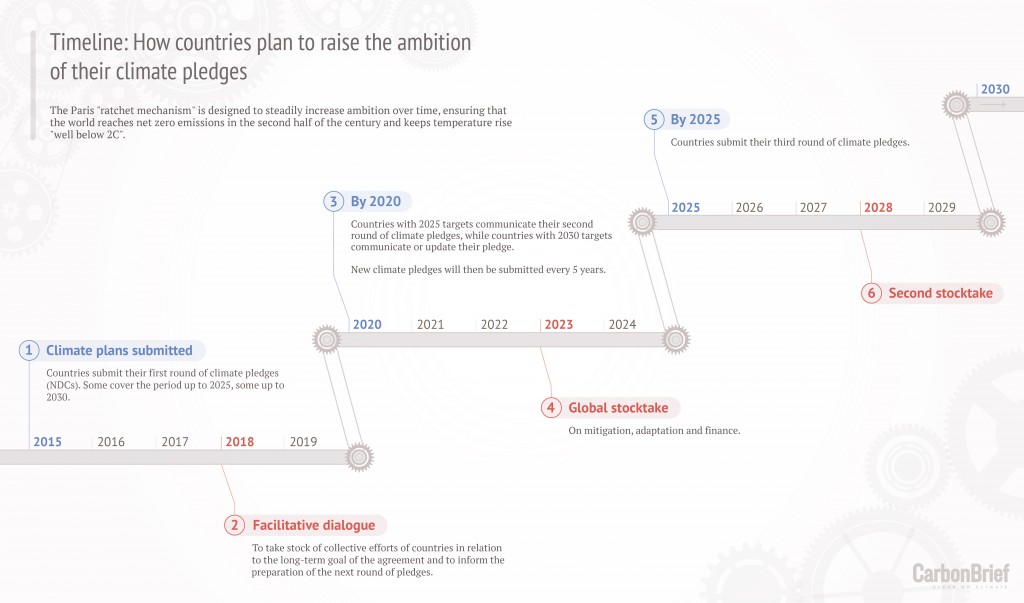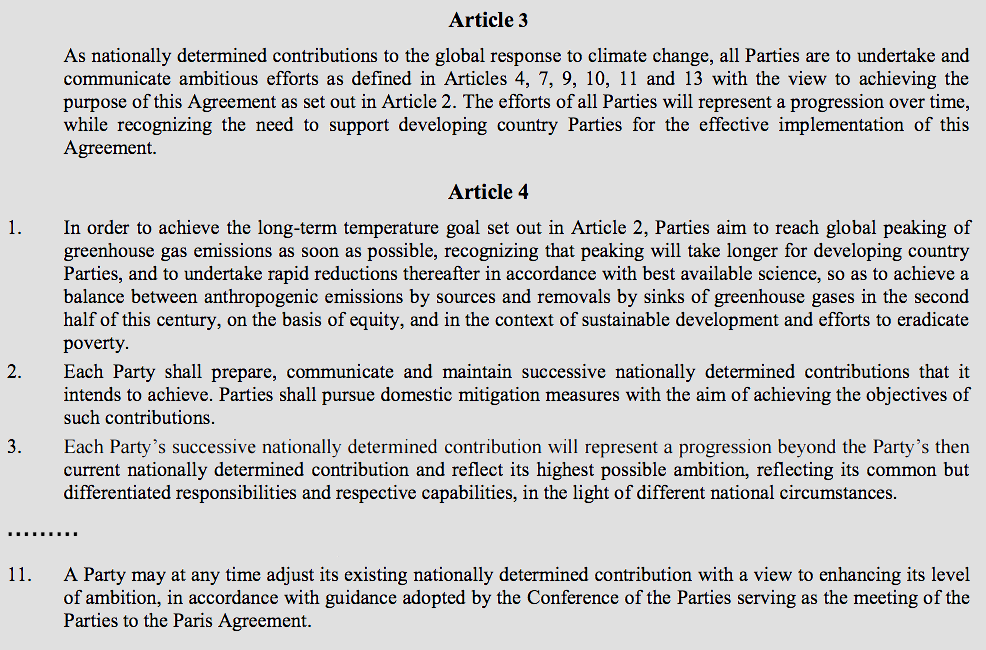
Guest post: Can the US legally weaken its Paris Agreement climate pledge?

Jonathan Church
05.08.17
Jonathan Church
08.05.2017 | 4:52pmAfter months of speculation, the Trump administration is expected to announce soon whether the US will remain part of the Paris Agreement on climate change. Debate has centred on whether Article 4 of the text prohibits the US from weakening its Paris pledge. In this guest article, Jonathan Church, lawyer for legal NGO ClientEarth, offers his interpretation of the language in question.
The Paris Agreement on climate change is designed to weather the peaks and troughs of political commitment, over time and from country to country, while ensuring that ambition ratchets inexorably upwards over time.
Part of the US administration’s calculation may be: just how much flexibility is there in the Paris Agreement? Just how little can we get away with doing without needing to pay the diplomatic price of withdrawal?
A view apparently gaining the upper hand is that the US could lawfully go so far as to lower the ambition of its emissions reduction pledge; its NDC (nationally determined contribution). Let us call this the “permissive interpretation” of the text. Todd Stern, Barack Obama’s special envoy for climate change, recently said that the agreement stopped short of a legal bar on countries moderating their pledges, implicitly (perhaps) supporting this view. Laurence Tubiana, France’s special representative for the COP21 climate talks in Paris in 2015, has been more explicit, tweeting: “US gov CAN legally downsize NDC but politically they should not.”
Not such a clause but a political consideration. To be super clear: US gov CAN legally downsize NDC but politically they should not. https://t.co/zmFhuVFIrY
— Laurence Tubiana (@LaurenceTubiana) May 4, 2017
My view, however, is that the text of the agreement does not allow for downsizing – not straightforwardly in any case; not as a Trump administration might be minded to do. This follows from an understanding of the agreement as a whole, as well as from the language of the relevant article.
The importance of the ratchet
Article 31 of the 1969 Vienna Convention on the law of treaties provides that treaties should be interpreted “in the light of [their] object and purpose”. To consider the Paris Agreement as a whole: It is impossible to overstate the centrality of the ratchet mechanism to the success of Paris. It is the ratchet that provides the means of bridging the gap between the pledges that we have now and the pledges that we will need in future to meet the agreement’s temperature goals.

Timeline: How countries plan to raise the ambition of their climate pledges. By Rosamund Pearce for Carbon Brief.
It is the ratchet that underpins the agreement’s most important objectives: providing a clear sense of direction and building momentum over time. The permissive interpretation would mean the ratchet was barely a ratchet at all.
Further, the key provisions in the agreement that establish the ratchet – those that require “the efforts of all Parties [to] represent a progression over time” (Article 3) and “each Party’s successive NDC [to] represent a progression beyond the Party’s then current NDC and reflect its highest possible ambition” (Article 4(3)) – should not be denuded of weight by an arguable interpretation of another provision, Article 4(11).

Let us look at that article in more detail. It reads:
“A party may at any time adjust its existing NDC with a view to enhancing its level of ambition…”
The following arguments might be made in favour of the “permissive interpretation”.
‘Non-binding’?
It may be argued that there are no penalties or sanctions that can be brought against a party for adjusting its NDC downwards. This argument might be expressed in terms of the provision being non-binding or not mandatory.
That no hard sanctions would follow from breaching Article 4(11) is true, as far as it goes, but this is really an argument on a different, more general, point. Provisions of international law may or may not be backed up by firm sanctions, but this does not make them any more or less “the law”; it merely means that different consequences follow when different provisions are breached.
International law is inherently voluntary. It is binding insofar as parties sign up to it and understand it to be binding. So talk of bindingness is something of a red herring. The price paid in breaching a law may or may not be financial – but it will always involve reputational damage to the country in breach, and an undermining of the strength of international law more broadly, to the detriment of that country and others.
Woolly words?
The second argument is more pertinent. It says simply that “with a view to” is soft language; it doesn’t carry a positive obligation to achieve something. In fact it doesn’t carry any positive obligation at all.
The former point may well be true, but the latter, crucially, is not. This phrasing carries a positive obligation to hold a certain intention when an NDC is adjusted: to be acting in the service of enhancing overall long-term ambition.
This is plainly a provision that, in keeping with Articles 3 and 4(3), points “upwards”, even if in soft language. No-one could argue that back-sliding was explicitly permitted by Article 4(11). And nor should it be inferred, given the sense of the agreement more broadly, as described above.
Article 4(11) does not say “no backsliding” and it does not say “backsliding is permitted”. That much seems clear. [A senior US negotiator at the Paris talks notes that an explicit prohibition on backsliding was considered, but rejected].
Even if the phrasing was more ambiguous, such that interpretative guidance could be sought out in earlier negotiating drafts of the provision, I don’t believe it would suggest anything different.
Fascinating to see how Art 4.11 (NDC revisions) looked 1wk before final Paris draft agreed. Only allowed lower ambition under special circs. pic.twitter.com/eEUGpKxt25
— Simon Evans (@DrSimEvans) May 3, 2017
A true reading of Article 4(11) lies somewhere between the two absolutes of prohibition and permission. In other words: “some backsliding can sometimes be permitted”. The wording of earlier drafts of Article 4(11) is not at odds with this – it appears to be intended to better delimit exactly when that backsliding could occur. The stripped-down provision with which we are left leaves more room for disagreement about when. But the overall sense is the same. It is still clear that backsliding for its own sake is prohibited.
In effect, Article 4(11) keeps the door ajar for an NDC to be adjusted “sideways” or even to edge downwards (remembering how difficult it can be to definitively say whether one NDC is more ambitious than another), provided that such adjustments are being made “with a view to” enhancing ambition.
To attempt an analogy: If the rules of football were more prescriptive they might read, “Players must kick the ball with a view to scoring in the opposing team’s goal”. Under such rules, players could shoot at goal, of course. They could certainly cross the ball from the wing into the opponent’s penalty area. They could even pass the ball backwards to their own goalkeeper, if in the circumstances that seemed the best or only chance, ultimately, of building an attack and scoring a goal. But some actions would nonetheless be positively prohibited. Kicking the ball into your own team’s net could not be an action taken “with a view” to scoring at the right end. The language is not precise, but it still has its limits.
The limits of flexibility
Back to the real world. What might a permitted NDC downsizing – akin to a constructive back-pass – look like? We might imagine a developing country temporarily unable to implement its NDC and opting to slacken the pace of emissions reductions for a time rather than pursue a course which would prove unsustainable and damage its capacity to achieve long-term progress. We might imagine a developed country wishing to re-prioritise which sectors it intended to focus its efforts on, with the effect that progress over the short term might be dampened slightly, but deeper longer-term reductions made more cost-effective or technologically feasible.
But certain adjustments – like own goals – will be prohibited, and it is not hard to imagine examples: a country downgrading its ambition in order to generate jobs in the coal industry, or in order to send a message that it is sceptical of the cause of climate change. Such adjustments would simply not be allowed.
The practical question for many who value the Paris Agreement has become: what would be worse – an agreement without the US, or an agreement whose ratchet mechanism was watered down by an (in my view) unduly permissive interpretation of Article 4(11)?
If a weakened NDC is the price for keeping the US within the agreement, the best response will be to understand that for what it is: a breach of the Paris Agreement.
-
Guest post: Can the US legally weaken its Paris Agreement climate pledge?

